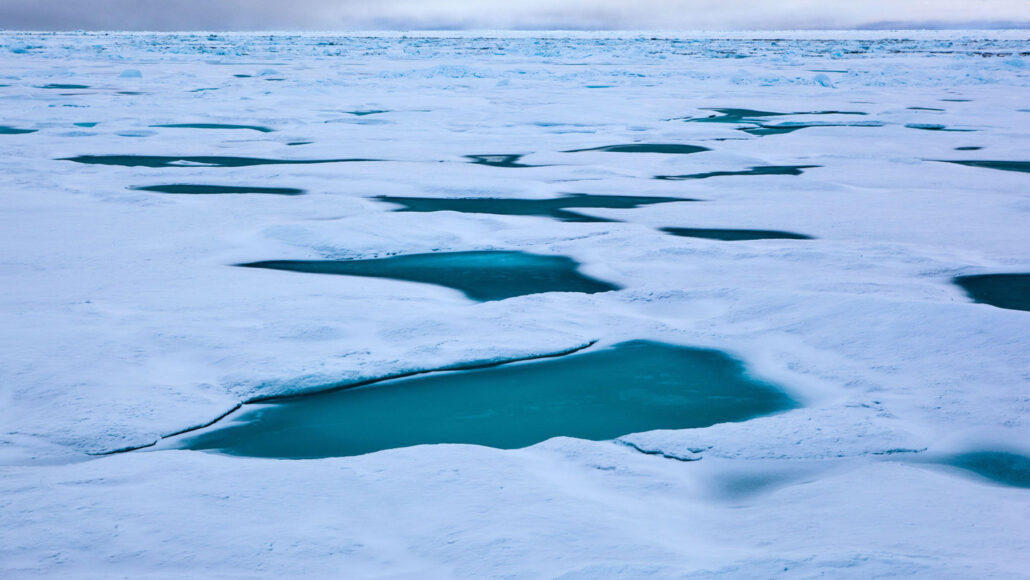Impending Shift in Winds Might Hasten Arctic Sea Ice Melting

A flip-flopping, yearslong pattern of winds helps control the fate of the Arctic’s sea ice — by regulating how much of the Atlantic Ocean’s relatively warm, salty water sneaks northward into the Arctic Ocean.
From 2007 to 2021, winds over North America and Eurasia were circulating in such a way that they reduced the influx of warmer Atlantic water into the Arctic, researchers report in the Sept. 1 Science. That helped slow the rate of sea ice loss during that time period — even as atmospheric warming ramped up (SN: 8/11/22). But that grace period may come to an end within just a few years. When the winds shift back, enhanced “Atlantification” of the Arctic may speed up sea ice loss, by giving an extra oomph of warming from below.
“This phase has lasted about 15 years. We’re about at the end,” says physical oceanographer Igor Polyakov of the University of Alaska Fairbanks. “The sea ice will be responding. There’s a great possibility for this rapid change in the system.”
Earth’s busy, interactive layers of ocean and atmosphere feature many different regional and global patterns that toggle between two different phases over years to decades, such as the El Niño and La Niña phases of the El Niño Southern Oscillation (SN: 6/15/23).
The Arctic Dipole is a smaller-scale, regional pattern of winds that is having a global impact, Polyakov and colleagues suggest. To assess its influence, the researchers compared atmospheric wind patterns since 1979 with trends in summer ice extent and thickness gathered from satellite, airplane and shipboard surveys over that time frame. A clear relationship emerged, they say.
From 1979 to 2006, the Arctic Dipole was in a “negative” phase, with winds rotating counterclockwise over North America and clockwise over Eurasia. That brought more Atlantic water into the Arctic via the Fram Strait, a narrow strip of ocean between Greenland and Norway’s Svalbard archipelago. During that time period, summertime sea ice extent shrank rapidly from year to year, vanishing at a rate of about 1 million square kilometers per decade.
The year 2007, a record-breaking year for Arctic sea ice loss, marked the end of this “negative” phase of the Arctic Dipole (SN: 12/9/20). From then until 2021, the rate of sea ice loss across the entire Arctic slowed, shrinking by only about 70,000 square kilometers per decade — largely due to atmospheric warming,
That’s not to say that the ice has recovered. It remains at a very low extent compared to the historical record. Human-caused global warming has ramped up heating across the region and created feedback loops that enhance sea ice loss: Melting sea ice exposes more ocean surface to the sun, warming that surface water, in turn enhancing ice melt.
But the current, “positive” phase of the Dipole has helped put the brakes on the dramatic rate of Arctic sea ice loss — for now, Polyakov says. Less Atlantic water flowing in through the Fram Strait means the waters of the Arctic Ocean remain stratified — tightly layered, with the less-dense, colder, fresher Arctic water sitting on top of the warmer Atlantic waters like a lid on a pot.
That’s been protecting the sea ice from melting from below, says Thomas Rippeth, a physical oceanographer at Bangor University in Wales who was not involved in the new study. Whether another switchover in the Arctic Dipole is about to occur, shifting winds and encouraging more warm waters to flow northward, isn’t yet clear, Rippeth says. “This paper is telling us what to look for — that’s why it’s an important piece of work.”
Our mission is to provide accurate, engaging news of science to the public. That mission has never been more important than it is today.
As a nonprofit news organization, we cannot do it without you.
Your support enables us to keep our content free and accessible to the next generation of scientists and engineers. Invest in quality science journalism by donating today.




